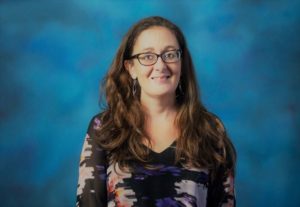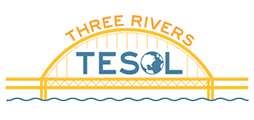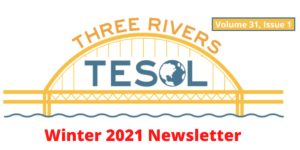PennTESOL-East virtual conference: “Mapping Today’s Curriculum”
By Lara Hauer
 The Fall 2020 PennTESOL-East virtual conference, “Mapping Today’s Curriculum,” was held Saturday, November 21, opening at 8:30 a.m. on Zoom. The conference was convenient and smoothly facilitated when moving between the main session and breakout rooms. Conference participants were able to choose from several synchronous sessions in two separate breakouts (9:45-10:45 and 11-12) in 30 or 60-minute segments.
The Fall 2020 PennTESOL-East virtual conference, “Mapping Today’s Curriculum,” was held Saturday, November 21, opening at 8:30 a.m. on Zoom. The conference was convenient and smoothly facilitated when moving between the main session and breakout rooms. Conference participants were able to choose from several synchronous sessions in two separate breakouts (9:45-10:45 and 11-12) in 30 or 60-minute segments.
The first plenary, “Developing Curriculum for Multilingual Learners and Teachers,” was given promptly at 9 a.m. for over 100 participants by Dr. MaryAnn Christison (University of Utah) and Dr. Anna Krulatz (Norwegian University of Science and Technology). Donning our “curriculum designer hats,” MaryAnn asked us to consider the key components of curriculum development: (1) understanding context, (2) key processes, and (3) types of curriculum. They introduced frameworks for linguistic based, content based, learner based, and learning based curricula in multilingual contexts, which are the “new norm” in today’s increasing linguistically diverse schools. Most striking to me was Anna’s presentation of MADE (Multilingual Approach to Diversity in Education) indicators as a tool for instructional design. In the MADE approach, teachers are agents of change and must support multiliteracies; teacher education programs should challenge monolingual ideologies and beliefs; and the classroom should be a “multilingual space” where student diversity is made visible and language varieties are heard.
A conference theme that got my attention was culturally responsive pedagogy and classrooms. For example, in the first breakout, Anneke Forzani, President and Founder of Language Lizard, introduced her company who develops multicultural resources for teachers with the goal of promoting culturally responsive classrooms and multilingual literacy (see https://www.languagelizard.com/Articles.asp?ID=352; subscribe to Language Lizard on YouTube). They provide bilingual children’s books in over 40 languages, targeting the principles of relevance to students’ uniqueness, a focus on their assets, and engagement in learning. In resources that portray many cultures, students can see themselves represented in the class (see also Multicultural Children’s Book Day). To facilitate home-school connections, Anneke suggests having a classroom lending library with bilingual books, and encouraging children to read with their parents to develop L1 -L2 literacy. Materials such as world folktales and fables can also be integrated in core subjects in a multicultural context, and can build community in diverse classrooms (see Living in Harmony series and poster; pen pal audio recorder). For teacher preparation programs for pre-service teachers, Anneke encourages self-reflection and analysis of our own biases. Anneke’s presentation was informative and gave me something to share with my pre/in-service teachers at Point Park.
In a full-hour interactive presentation, “REAL Talk: Reflections on Race, Education, and Language” in the second breakout, discussion was sparked by Brenda Muzeta (Kutztown University of Pennsylvania), Dr. Kathryn Accurso, and Denise Blanch (both from University of British Columbia). After giving a land acknowledgement, the presenters gave us a link with a freewriting prompt to ignite thinking about issues surrounding race, racism, anti-racism, racial justice, today’s protests, and inequity, all issues about which we need to talk openly. It’s our personal responsibility to prepare international students to deal with issues and connect to their “real-life experiences in the here and now.” They pointed out five shocking “main threads” in research: (1) Teacher bias matches the general public; (2) North American schools are “colorblind and color mute” in beliefs, biases, attitudes, labels; (3) Unexplored racism and whiteness is toxic, emotional; (4) Linguistic racism, power, privilege exists in “academic language”; and (5) Inclusion is not enough. With these challenges in mind, participants responded to the question “How to decenter whiteness in ELT?” This discussion highlights the importance of self-awareness and education, racial healing, action orientation, and the need to push beyond our comfort zone (see Project Implicit, https://implicit.harvard.edu/implicit/).
In the second plenary, “Designing Courses, Making Changes,” at noon, Dr. John Macalister (Victoria University, New Zealand) captivated us by narrating a case study of an English curriculum in Saudi Arabia that he was recently asked to develop. Using a “KWL” approach, John analyzed the environment and needs of the learners at the intended job site. Through this extended example, he visually presented a subdivision of principles in curriculum design: (1) content and sequencing (what to teach, what order), (2) format and presentation (how to teach it), and (3) monitoring and assessment (how we know/observe that learners are learning). He provided examples of how to adapt curriculum by changing context of activities to relate to learners, reduce the language learning burden, and make the most of prior knowledge through interaction, scaffolding, and repetition (see https://www.retrievalpractice.org).
After closing remarks at 1:15 p.m., there were several asynchronous sessions with synchronous Q&A available. I chose to attend “Engaging Learners Online with Culturally Responsive Pedagogy (CRP),” by Nebai Shah, Abigail Stein, and Katrin Weisbach, in the MATESOL program at University of Delaware (see https://www.youtube.com/watch?v=jp-J_A2EUgw&feature=youtu.be&ab_channel=AbigailStein). The presenters discussed six principles of CRP: Incorporate students’ existing knowledge and strengths, Provide opportunities for negotiation of learning goals, Value students’ lived experience by using them in the classroom, Make use of student generated materials, Expose students to diverse perspectives, Provide opportunities to apply what students learn to personally meaningful contexts outside the classroom. They also detailed an “identity circles activity” that can be adapted and used by teachers. This is another takeaway that I will use with my Point Park School of Education courses.
Two additional presentations I recommend are: “Social Justice in Language Education: An Interview with Ingrid Piller from Macquarie University, Dr. Carla Chamberlin-Quinlisk, Penn State University” moderated by “Mac” Khan (Community College of Philadelphia) (see https://youtu.be/SLQp_D2fA1k), and “Curriculum Conversations: Brainstorming Uses of the Soon-to-be Released 2020 Edition of the WIDA ELD Standards” by Fernanda Kray and Elisabet Sena (University of Wisconsin Madison) (see 2020 Vision for Standards | WIDA (wisc.edu).
Overall, this was a fantastic professional development activity and a great use of a Saturday.
Laura Hauer is an instructor at Point Park University. You can contact her atlmhauer77@gmail.com.

